
|
Awadh consisted of much of the modern state of Uttar Pradesh. Soon after the death of Aurangzeb in 1707, the Mughal empire began to fragment as there was a
continual struggle for power at the center. Sadat Khan had been appointed the Mughal governor of the province in 1720 and was the first to start behaving somewhat
independently, taking advantage of the lack of central control. His capital was Faizabad. In 1737, he opened a mint in Banaras, calling it Muhammadabad Banaras, and started
to issue coins there in the name of the Mughal emperor.
In 1763, the Nawab of Bengal, Mir Kasim, attempted to confront his erstwhile masters, the British, and was routed. He sought refuge in Awadh and in 1764, the combined
forces of Mir Kasim, Awadh and the Mughal emperor Shah Alam II marched east in an attempt to recover Bengal. The British, despite being heavily outnumbered, defeated the
Muslim armies at the Battle of Buxar. In the aftermath, Awadh lost the eastern half of its territory, including Banaras, and was compelled to pay a large annual tribute to the British.
The mint was moved to Lucknow. From there, coins in the name of the Mughal emperor continued to be struck, and they continued to name Muhammadabad Banaras
as the mint. It was only in 1819 that Nawab Ghaziuddin Haidar finally started to strike coins in his own name. Soon thereafter, Awadhi coins started to feature the kingdom's
European style coat of arms.
Awadh was at the center of events surrounding the war of independence ("the mutiny") in 1857. Ever since the Battle of Buxar, the British had essential control over "Oudh,"
and the degree to which they exercised this control had steadily increased over the years. Finally, in 1856, citing the corruption and lack of proper administration in the country,
they annexed Oudh to direct British control and pensioned off the Nawab, Wajid Ali Khan. During the revolt, Wajid Ali's son, Birjis Qadr, was proclaimed Nawab and a few coins
were struck in the name of the Mughal emperor Shah Alam II. Once the British reacquired control, the kingdom of Awadh disappeared forever.
|
 |
Anonymous issues (1737-1819) |

|
Awadh: Silver rupee in name of Shah Alam II, Banaras, AH 1189, RY 16
Weight: 11.09 gm. Diameter: 23 mm Die axis: 2 o'clock
Legend, mintmarks sun, star and sprigs, and AH year 1189 (= 1774-1775 CE) /
Legend, including mint name Muhammadabad Banares and regnal year 16
Reference: KM 36.3ff
|
 |
This is one of the last coins issued before the East India Company acquired the mint at Banares from the Raja of Awadh in 1776, and
served as the prototype for the beautiful EIC coinage from that mint. This coin shows a sun mintmark (in the form of six pellets) on the obverse and the curent regnal year only on
the reverse. The coins issued from this mint by the EIC replaced the sun with a fish mintmark and showed a double regnal year, the fixed RY 17 (the RY of the first British issues)
and then the progressive RY until the death of Shah Alam II in his RY 49. This coin was issued in AH 1189, the year in which the transition from Shuja ud Daulah to Asaf ud
Daulah as nawab took place, so it could have been issued in either one's reign.
|
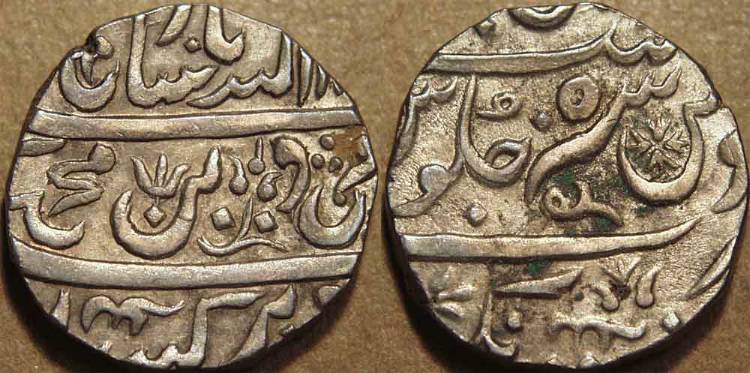
|
Awadh: Silver rupee in name of Shah Alam II, Jhansi, RY 5
Weight: 11.24 gm. Diameter: 21 mm Die axis: 5 o'clock
Legend, including unusual mintmarks trident and leaf sprig /
Legend, including regnal year 5 (= AH 1176 = 1762-63 CE) and Jhansi mintmark
Reference: KM 79 var.
|
 |
This coin follows the pattern of KM 79 in the Maratha listings and continues the Maratha types from Jhansi. However, the unusual
mintmarks of the trident and leaf sprig on the obverse reveal that this coin was issued during the brief period during which Awadh acquired control of the Jhansi mint. This was
while Shuja ud Daulah was the nawab of Awadh.(My thanks to Jan lingen for his help in identifying this coin.)
|
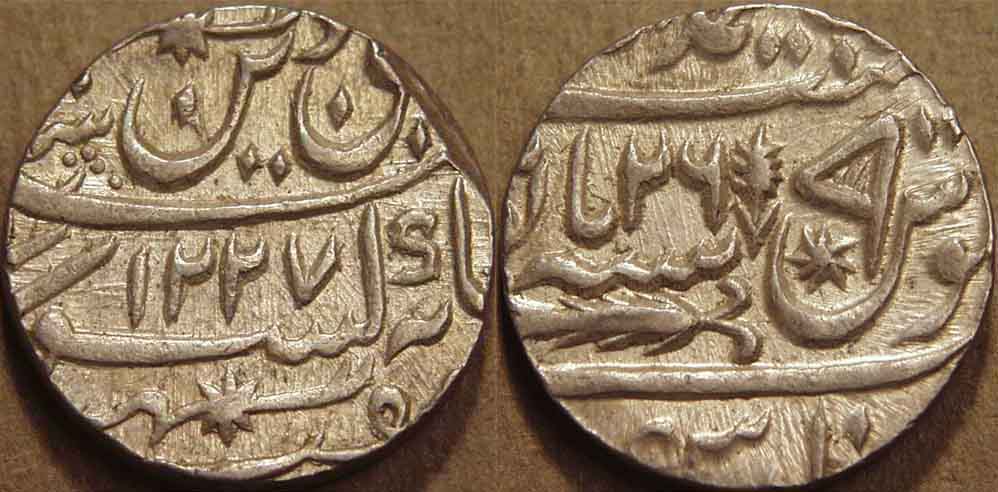
|
Awadh: Silver rupee in name of Shah Alam II, Lucknow, AH 1227, RY 26
Weight: 11.13 gm. Diameter: 22 mm Die axis: 2 o'clock
Legend with stars, AH date 1227 (= 1812-13 CE) /
Legend, including frozen regnal year 26 and flag and star mintmarks
Reference: KM 103.2
|
 |
The Awadh issues in the name of Shah Alam II use a frozen RY date of 26. The date of issue can be determined by the AH date.
Note the leaf sprig next to the RY date.
|

|
Awadh: Silver rupee in name of Shah Alam II, Lucknow, AH 1227, RY 26
Weight: 11.13 gm. Diameter: 22 mm Die axis: 2 o'clock
Legend with stars, AH date 1229 (= 1814-15 CE) /
Legend, including frozen regnal year 26 and flag and star mintmarks
Reference: KM 103.2
|
 |
On this coin the normal sprig next to the RY date has been replaced by a cross-shaped object (plant?).
|

|
Awadh: Silver rupee in name of Shah Alam II, Lucknow, RY 26
Weight: 11.13 gm. Diameter: 22 mm Die axis: 11 o'clock
Legend with stars, AH date off flan /
Legend, including frozen regnal year 26 and flag and star mintmarks
Reference: KM 103.2
|
 |
The AH date is off the flan of this coin; the benefit of that is that we see the top register of the obverse, almost never seen on these
coins.
|
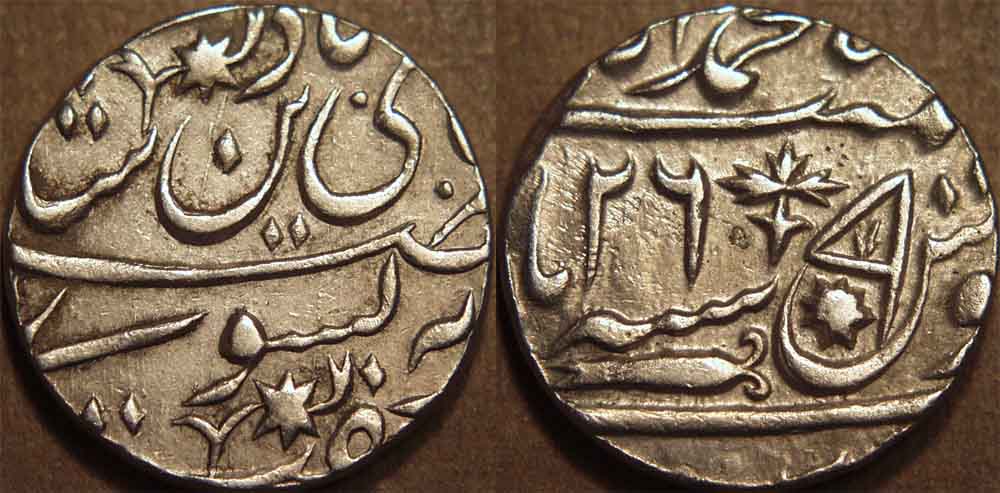
|
Awadh: Silver rupee in name of Shah Alam II, Lucknow, no AH date, RY 26
Weight: 11.18 gm. Diameter: 23 mm Die axis: 9 o'clock
Legend with stars, no AH date /
Legend, including frozen regnal year 26 and flag and star mintmarks
Reference: KM 103.3
|
 |
This coin is an extremely rare variant that does not show an AH date.
|
 |
 |
 |
Nasir-ud-din Haidar (1827-1837) |
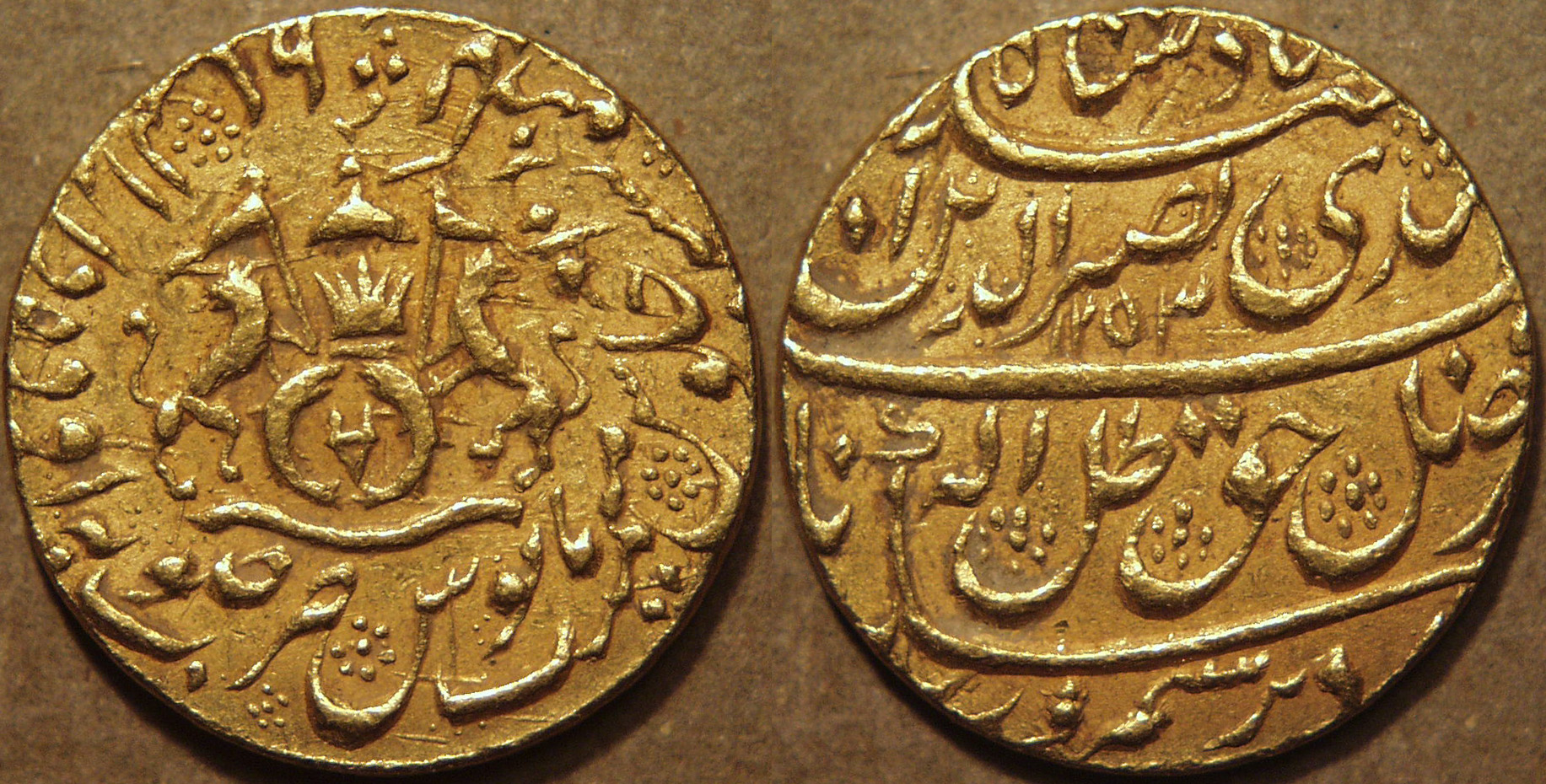
|
Awadh: Nasir-ud-din Haidar (1827-1837) Gold ashrafi, AH 1203, Lakhnau
Weight: 10.70 gm. Diameter: 22 mm Die axis: 6 o'clock
Awadh coat of arms surrounded by legend /
Legend, including AH date 1253 (=1837 CE) and regnal year 10
Reference: KM 240 var
|
 |
The date on this coin is not listed in KM and must have been from the last year of Nasir-ud-din's reign. He was poisoned at the age of 34.
Note the coat of arms on this coin is an early version of the Awadh symbol, which includes two lions holding the pennants and two fish below. Also, there is a dagger between the
two fish, instead of the usual legend seen in this position.
|
 |
 |
 |
Wajid Ali Shah (1847-1856) |
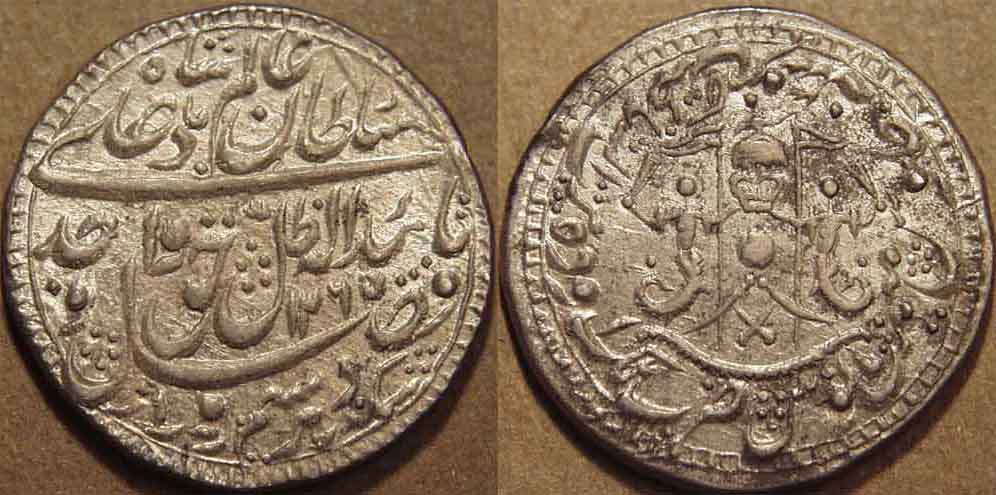
|
Wajid Ali Shah Silver rupee, Baitu-s-Sultanat Lakhnau, AH 1265, RY 3
Weight: 11.16 gm. Diameter: 25 mm Die axis: 12 o'clock
Legend including AH date 1265 (= 1849 CE) and mint name Baitu-s-Sultanat /
Awadh coat of arms with legend around and RY 3
Reference: KM 365.1
|
 |
The Lakhnau coins of Wajid Ali Shah have three varieties of the mint name. This coin shows the first variety: Baitu-s-Sultanat
Lakhnau. Note the coat of arms now have eliminated the lions and feature two fish holding the pennants. The fish was the dynastic symbol of the Nawabs of Awadh.
|
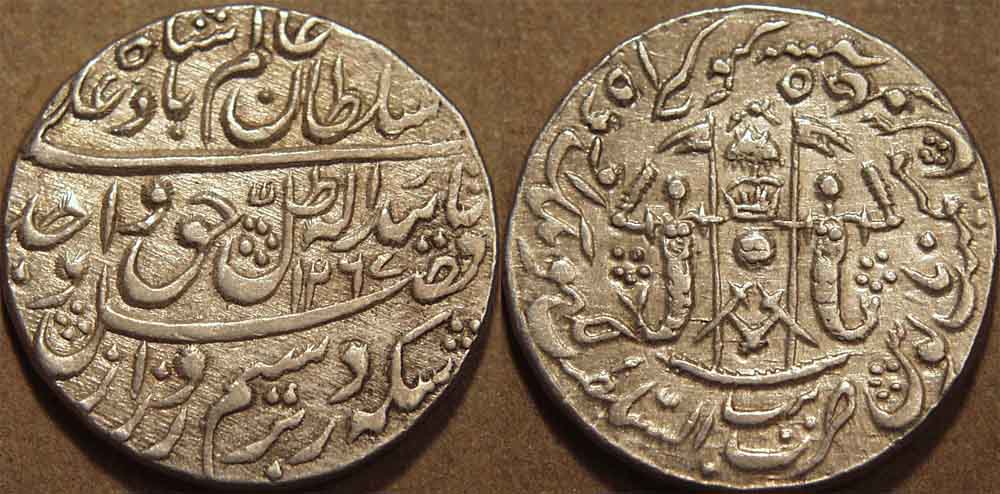
|
Wajid Ali Shah Silver rupee, Baitus-s-Sultanat Lakhnau Mulk Awadh
Akhtarnagar, AH 1267, RY 5
Weight: 11.13 gm. Diameter: 25 mm Die axis: 2 o'clock
Legend including AH date 1267 (= 1851 CE) and mint name Baitus-s-Sultanat
Mulk Awadh Akhtarnagar /
Awadh coat of arms with legend around and RY 5
Reference: KM 365.1
|
 |
This coin shows the third variety: of the mint name: Baitus-s-Sultanat Lakhnau Mulk Awadh Akhtarnagar.
|

|
Wajid Ali Shah Copper 1/8 falus, Baitus-s-Sultanat Lakhnau, AH 1270, RY 8
Weight: 1.54 gm. Diameter: 12 mm Die axis: 12 o'clock
Legend including AH date 1270 (= 1854 CE) and RY 8 /
Awadh coat of arms with legend around
Reference: KM 345
|
|
|